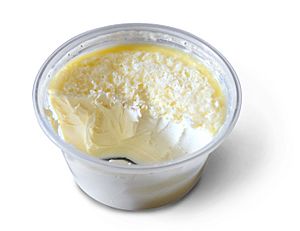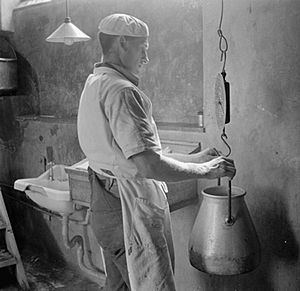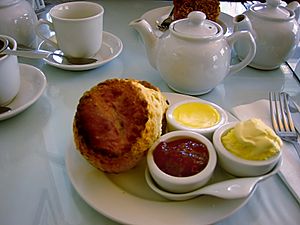Clotted cream facts for kids

A tub of clotted cream, showing top crust.
|
|
| Alternative names | Clouted cream, Cornish cream, Devonshire cream |
|---|---|
| Place of origin | England |
| Region or state | Cornwall, Devon |
Clotted cream (Cornish: dehen molys) is a super thick and yummy cream. It's made by gently heating full-cream cow's milk and then letting it cool slowly. As it cools, the cream rises to the top and forms "clots" or "clouts." That's how it got its name! This special cream is a key part of a cream tea.
We don't know exactly when or where clotted cream first appeared. But it's strongly linked to dairy farms in South West England, especially in Cornwall and Devon. The biggest company making clotted cream in the UK today is Rodda's in Cornwall. They can make tons of it every day!
In 1998, "Cornish clotted cream" got a special protection from the European Union. This means only cream made in Cornwall from Cornish milk, with at least 55% fat, can be called "Cornish clotted cream."
| Top - 0-9 A B C D E F G H I J K L M N O P Q R S T U V W X Y Z |
What is Clotted Cream?
"Its orient tinge, like spring-time morn,
Or baby-buttercups newly-born;
Its balmy perfume, delicate pulp,
One longs to swallow it all at a gulp,
Sure man had ne'er such gifts or theme
As your melt-in-mouthy Devonshire cream."
—William Barry Peacock, Manchester, 1853
Clotted cream has a unique taste. People describe it as "nutty" or like "cooked milk." It's also rich and sweet. The texture is thick and sometimes a bit grainy. It has a very high fat content, usually around 64 percent. To compare, regular single cream has only about 18 percent fat.
This rich cream is often enjoyed with desserts. It's a treat that many people love!
A Look Back: History of Clotted Cream
Farmers first made clotted cream to use up all their milk. It became a big part of the culture in southwest Britain. Now, it's even a popular reason for tourists to visit the area! We know it's been around for a long time in Cornwall and Devon, but its exact age is a bit of a mystery.
Some old stories say that Phoenician traders brought the idea to Cornwall. They were looking for tin. Clotted cream is similar to a cream called kaymak, which is made in many places like the Middle East and parts of Asia. A similar cream is also made in Mongolia.
Ancient food experts think early Britons might have made clotted cream. They would have done this to keep milk fresh longer. Some old stone buildings, like the Cornish fogou, might have been used as cool storage places for dairy products like cream and cheese.
People from Devon and Cornwall have argued for ages about where clotted cream first came from. They also argue about which county makes it best! There's proof that monks at Tavistock Abbey in Devon were making it in the early 1300s. After their abbey was attacked, local workers helped rebuild it. The monks thanked them with bread, clotted cream, and strawberry jam. An old cookery book from 1658 even had a recipe for "clouted cream."
In the 1800s, clotted cream was thought to be healthier than "raw" cream. Raw cream could go bad easily and make people sick. Making clotted cream also produced more cream than other methods. In Devon, it was so common that people even used it to make butter. This butter lasted longer and tasted better.
For a long time, people in southwest England would send small tins of clotted cream by mail. They would send them to friends and family in other parts of the UK.
Special Protection for Cornish Cream
In 1993, people wanted "Cornish clotted cream" to have a special protected status in the European Union. This was approved in 1998. It means Cornish clotted cream must be made from milk from Cornwall. It also needs to have at least 55 percent fat. The slightly yellow color of Cornish clotted cream comes from the high levels of carotene in the grass the cows eat.
How Clotted Cream is Made
Traditionally, clotted cream was made by letting fresh milk sit in a shallow pan. The cream would rise to the top. Then, it was gently heated over hot coals or in a water bath. After that, it cooled slowly. The thick "clots" that formed on top were then carefully scooped off.
Today, there are two main modern ways to make clotted cream. Both methods involve heating cream in shallow trays using steam or hot water. After heating, the cream is cooled slowly for many hours. Then, it's separated and packaged. This process makes the cream safe to eat, similar to pasteurized milk.
The biggest maker of clotted cream in the UK is Rodda's. It's a family business in Cornwall. They started in 1890. In 2010, they could make up to 25 tons of cream a day during busy times like Christmas! Rodda's even sends small tubs of clotted cream to airlines for in-flight desserts. The Wimbledon tennis championships are one of their busiest times for sales.
Some other farms and dairies in southwest England also make clotted cream. You can find it in places like Somerset, Dorset, and the Isle of Wight. If you can't find real clotted cream, you can make something similar. You can mix mascarpone cheese with whipped cream, a little sugar, and vanilla.
Ways to Enjoy Clotted Cream
The Famous Cream Tea
Clotted cream is a must-have for a cream tea. This is a favorite treat for tourists in Cornwall and Devon. It's served on warm scones (or traditional "splits") with strawberry jam and a pot of tea.
There's a fun debate about how to eat a cream tea! In Devon, people usually spread the cream first on the scone, then add a dollop of jam. In Cornwall, they do it the other way around: jam first, then cream. Cream teas, also called Devonshire teas, even spread to southern Australia. Early immigrants from Cornwall and Devon took their recipes with them.
One fun variation of a cream tea is called "Thunder and Lightning." This is a piece of bread topped with clotted cream and golden syrup, honey, or treacle.
Sweet Treats
Clotted cream is great with many hot or cold desserts. It's often used in southwest England to make delicious ice cream and fudge.
Savory Dishes
You can even use clotted cream in some savory dishes! Try mixing it into mashed potatoes, risotto, or scrambled eggs for a rich taste.
Old-Fashioned Delights
In the mid-1600s, there was a dessert called "cabbage cream." It didn't have cabbage! It was layers of clotted cream with sugar and rosewater. When served, it looked a bit like a cabbage. It was also often eaten with junket, a milk-based dessert that isn't very common anymore.
Clotted Cream in Stories
Clotted cream has appeared in poems and old stories. For example, it was mentioned in a poem called The Shepheardes Calendar by Edmund Spenser in 1579:
Ne would she scorn the simple shepherd swain,
For she would call him often heam,
And give him curds and clouted cream.
Like many things from Cornwall and Devon, clotted cream is part of local folklore. One myth tells of a girl named Jenny. She fed clotted cream to a giant named Blunderbore. He loved it so much that he fell in love with her and made her his wife!
Another story from Dartmoor tells of a princess who wanted to marry an elven prince. She had to bathe in pure cream first. A witch kept souring the cream. But the prince offered the princess clotted cream, which the witch couldn't sour!
Clotted cream is also mentioned as a favorite food of the hobbits in J.R.R. Tolkien's The Lord of the Rings books.



